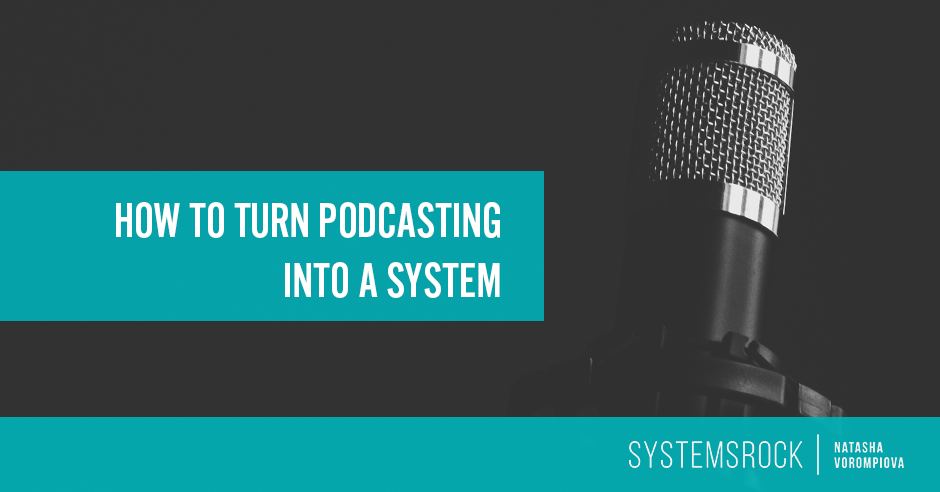You’ve started your podcast, and you’re loving it, but it’s also taking up a lot of space in your schedule. Podcasting takes time — time that you could be spending on other revenue-generating activities.
So how can you be more efficient when it comes to your podcast while still making sure it’s a valuable resource?
Start using a system!
3 Steps to Turn Podcasting Into a System
Step 1: Write down a list of all the tasks you’re currently doing for your podcast.
Set a timer for fifteen minutes. Write down all of the tasks that your team does to produce your Podcast. These tasks could happen weekly, monthly or even quarterly.
Examples of weekly tasks might be:
- Record episodes
- Write show notes
- Upload show to Libsyn/Soundcloud
- Title episode file
- Put recorded episode in Dropbox
- Create image for show notes
- Post image to Pinterest
Examples of quarterly tasks might be:
- Choose three themes for the next three months
- Brainstorm twelve guests to have on the show
Step 2: Organize your list of tasks into a timeline.
Take your list of tasks and organize them into stages.
Which tasks come before recording? Which come after? What happens once the show is published?
Some stages to consider are:
- Brainstorming/Reaching out – This phase may include tasks like compiling lists of potential guests, emailing them, setting a meeting date, and sending them a list of potential questions.
- Recording the episode – This may include a checklist of what to do before you start recording, like checking the sound quality or putting your phone in silent mode. If you’re recording video, checking the lighting.
- Post-production – This occurs after the episode has been recorded, and you’re completing tasks like creating show notes.
- After the episode has been published – This would include tasks like emailing your guests with the link to the show, marketing it on social media, and repurposing it to gain further visibility.
Once you’re finished, walk through the steps to see if you’ve missed any tasks. You won’t get everything 100% right the first time, and that’s normal.
In fact, you can treat any system you create as a living document that’s meant to evolve along with your business’s demands.
By breaking down the tasks into a timeline, you can get a clear picture of the tasks you’ve missed and where the most time is being spent.
Step 3: Create templates.
Once you have a good idea of the order of your tasks, create templates in your preferred project management system, like Asana, Evernote, or Trello.
You can create one large template for the entire process, or if it seems more manageable to you, create a template for each stage.
Now, whenever you or your assistant are working on that specific part of the podcasting process, you can refer to your template or checklist. Make sure that your team isn’t letting anything fall through the cracks.
What’s more, having the entire process written down helps you see where there might be bottlenecks. What tasks might you delegate? How can you further maximize your show?
When you create templates, you’ll have resources you can repeatedly return to make sure your entire podcasting process works smoothly and that the time you devote to it is well-spent.
Look For Opportunities
While you’re drafting your system, keep your eyes open for opportunities to save time or increase exposure to your podcast. If you have ideas that you aren’t able to implement now, but would like to see come to life, keep them stored in something similar to a “Someday, Maybe” file so you won’t lose track of it. Then, make a note to review your ideas next quarter.
Back To You
I’m curious, what are some of your favorite podcasts?
Mine is Profit, Power, Pursuit with Tara Gentile, where she uncovers both the strategic and the tactical components of how creative people make money, take control of their businesses, and pursue what’s most important to them so that you can too .



Great tips, Natasha! I would never have been able to publish consistent weekly episodes of my podcast, Nomadtopia Radio, without having a system. I created a template in Asana that I use for each podcast guest; it includes all of the tasks that need to be completed (by me or my team) before, during, and after the interview. This way nothing falls through the cracks and we all know where things stand.
Whoohoo, Amy!! 🙂 Yup, an Asana template is the way to go! 🙂